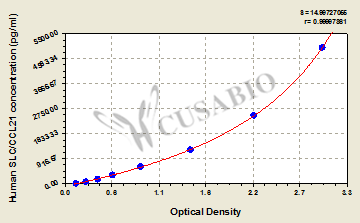The product CSB-E04521h is a sandwich ELISA kit developed to measure concentrations of human secondary lymphoid-tissue chemokine (SLC) in serum or plasma. This assay uses the sandwich enzyme immunoassay technique in combination with the enzyme-substrate chromogenic reaction to quantify the analyte in the sample. The color develops positively to the amount of SLC in samples. The color intensity is measured at 450 nm via a microplate reader.
SLC, also called CCL21, is a chemokine that mediates the recruitment of multiple leukocyte subsets through CCR7-mediated signaling during the steady-state and inflammation. It plays a vital role in the homing and localization of immune cells to lymphoid tissues. CCL21 is also involved in priming adaptive immunity via governing egress of dendritic cells (DCs) from barrier tissues and T cell entry and positioning in secondary lymphoid organs. CCL21/CCR7 signaling promotes growth and metastasis of many tumor types including melanomas, breast, thyroid, colon, head, and neck cancers.






